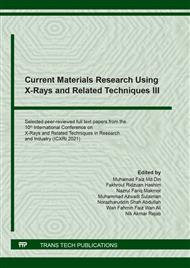[1]
M.F. Ashby, R.F.M. Medalist, The mechanical properties of cellular solids, Metall. Trans. A. 14 (1983) 1755–1769.
Google Scholar
[2]
J. Wang, R. Stevens, Review Zirconia-toughened alumina (ZTA) ceramics, J. Mater. Sci. 24 (1989) 3421–3440. http://link.springer.com/article/10.1007/BF02385721 (accessed September 11, 2013).
DOI: 10.1007/bf02385721
Google Scholar
[3]
W. Tuan, R. Chen, T. Wang, C. Cheng, P. Kuo, Mechanical properties of Al2O3/ZrO2 composites, J. Eur. Ceram. Soc. 22 (2002) 2827–2833. http://cat.inist.fr/?aModele=afficheN&cpsidt=14362725 (accessed April 19, 2012).
DOI: 10.1016/s0955-2219(02)00043-2
Google Scholar
[4]
U. Soy, A. Demir, F. Caliskan, Effect of bentonite addition on fabrication of reticulated porous SiC ceramics for liquid metal infiltration, Ceram. Int. 37 (2011) 15–19.
DOI: 10.1016/j.ceramint.2010.07.028
Google Scholar
[5]
X. Yao, S. Tan, Z. Huang, D. Jiang, Effect of recoating slurry viscosity on the properties of reticulated porous silicon carbide ceramics, Ceram. Int. 32 (2006) 137–142.
DOI: 10.1016/j.ceramint.2005.01.008
Google Scholar
[6]
N.A. Rejab, A.Z.A. Azhar, M.M. Ratnam, Z.A. Ahmad, The effects of CeO2 addition on the physical, microstructural and mechanical properties of yttria stabilized zirconia toughened alumina (ZTA), Int. J. Refract. Met. Hard Mater. 36 (2013) 162–166.
DOI: 10.1016/j.ijrmhm.2012.08.010
Google Scholar
[7]
Z.D.I. Sktani, A.Z.A. Azhar, M.M. Ratnam, Z.A. Ahmad, The influence of in-situ formation of hibonite on the properties of zirconia toughened alumina (ZTA) composites, Ceram. Int. 40 (2014) 6211–6217.
DOI: 10.1016/j.ceramint.2013.11.076
Google Scholar
[8]
H. Manshor, S. Aris, A. Zahirani, A.Z.A. Azhar, E. Chan, Z. Ari, et al., Effects of TiO2 addition on the phase, mechanical properties, and microstructure of zirconia-toughened alumina ceramic composite, Ceram. Int. 41 (2015) 3961–3967.
DOI: 10.1016/j.ceramint.2014.11.080
Google Scholar
[9]
A.R. Jamaludin, S.R. Kasim, A.K. Ismail, M.Z. Abdullah, Z.A. Ahmad, The effect of sago as binder in the fabrication of alumina foam through the polymeric sponge replication technique, J. Eur. Ceram. Soc. 35 (2015) 1905–1914.
DOI: 10.1016/j.jeurceramsoc.2014.12.005
Google Scholar
[10]
A.J. Sánchez-Herencia, R. Moreno, C. Baudín, Fracture behaviour of alumina-calcium hexaluminate composites obtained by colloidal processing, J. Eur. Ceram. Soc. 20 (2000) 2575–2583.
DOI: 10.1016/s0955-2219(00)00123-0
Google Scholar
[11]
I.-K. Jun, Y.-M. Kong, S.-H. Lee, H.-E. Kim, H.-W. Kim, K.C. Goretta, Reinforcement of a Reticulated Porous Ceramic by a Novel Infiltration Technique, J. Am. Ceram. Soc. 89 (2006) 2317–2319.
DOI: 10.1111/j.1551-2916.2006.00997.x
Google Scholar
[12]
M.M. Hossen, F.-U.-Z. Chowdhury, M. a. Gafur, a. K.M.A. Hakim, Structural and Mechanical Properties of Zirconia Toughened Alumina (ZTA) Composites, Int. J. Eng. Res. Technol. 3 (2014) 2128–2134.
Google Scholar
[13]
D. Casellas, M.M. Nagl, L. Llanes, M. Anglada, Fracture toughness of alumina and ZTA ceramics: microstructural coarsening effects, J. Mater. Process. Technol. 143–144 (2003) 148–152. doi:http://dx.doi.org/10.1016/S0924-0136(03)00396-0.
DOI: 10.1016/s0924-0136(03)00396-0
Google Scholar
[14]
A.Z.A. Azhar, M.M. Ratnam, Z.A. Ahmad, Effect of Al2O3/YSZ microstructures on wear and mechanical properties of cutting inserts, J. Alloys Compd. 478 (2009) 608–614.
DOI: 10.1016/j.jallcom.2008.11.156
Google Scholar
[15]
N.A. Rejab, Z.D.I. Sktani, T.Y. Dar, W.F.F.W. Ali, A.R. Jamaludin, Z.A. Ahmad, The capability of hibonite elongated grains to influence physical, microstructural, and mechanical properties of zirconia toughened alumina–CeO2–MgO ceramics, Int. J. Refract. Met. Hard Mater. 58 (2016) 104–109.
DOI: 10.1016/j.ijrmhm.2016.04.008
Google Scholar
[16]
K. Vishista, F.D. Gnanam, Microstructural development of SrAl12O19 in alumina-strontia composites, J. Eur. Ceram. Soc. 29 (2009) 77–83.
DOI: 10.1016/j.jeurceramsoc.2008.05.041
Google Scholar
[17]
D. Casellas, I. Rafols, L. Llanes, M. Anglada, Fracture toughness of zirconia-alumina composites, Int. J. Refract. Metals Hard Mater. 17 (1999) 11–20.
DOI: 10.1016/s0263-4368(98)00064-x
Google Scholar
[18]
Z.Y. Deng, J. She, Y. Inagaki, J.F. Yang, T. Ohji, Y. Tanaka, Reinforcement by crack-tip blunting in porous ceramics, J. Eur. Ceram. Soc. 24 (2004) 2055–2059.
DOI: 10.1016/s0955-2219(03)00365-0
Google Scholar


